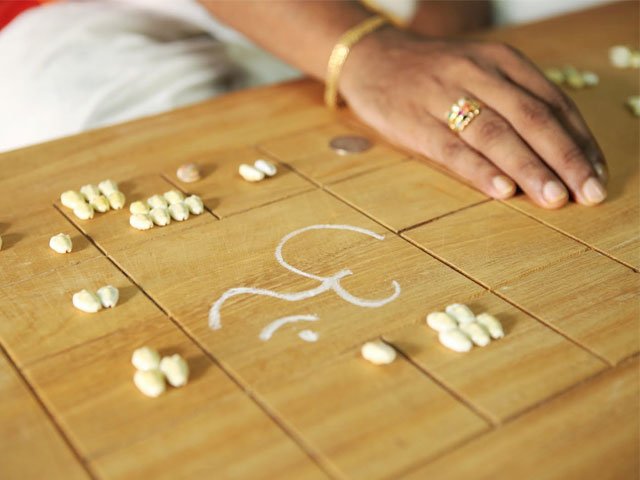

Astamangala : one of the most popular method practiced in kerala where, astrologer is called to perform a prashna. Astrologer first do worship or conduct a puja and gold coin is placed somewhere between zodiac drawn earlier. This is called aruda. Query is answered based on sutras.
Prasnam is a Sanskrit word which means a question or query. The astrologer answers that question with the help of planetary positions at the time of question and ‘Aaruda’, which is obtained using ‘Kavadi’ (sea shells). Below are the combinations of different methods of answering a query by an Astrologer
In Ashtamangala Prasnam, there are more additional points of references.
(a) It starts with inviting a learned Astrologer for Ashtamangala Prasnam. Invitation has to done with due respect.
(b) A date for conducting Prasnam will be given by the Astrologer. This Prasna will take minimum two days and it can extend to three or more days in proportion to the degree of problems/doshas (as the case may be). The start date should be one of the 16 stars which are suitable for Annaprasanam excluding the stars posited in 8th house from the Prichchaka’s Janma Rasi (the person who wants to conduct the Prasna/making query).
(c) There has to be a minimum of two Astrologers for debate.
(d) On the Prasnam day, a priest would perform Rasi Chakra puja and during that time, main Astrologer will ask a girl (should be kanya) or boy to keep the Gold coin (along with Rice, Paddy, Flower, Sandal & Water) in one of the twelve houses without pre-conceived thought.
(e) Prasnam then continues. After full diagnosis, remedial measures will be finalized on the last day of Prasnam.
(f) At the end, main Karmi/Vaidika/Tantric (who will head Parihaara Homam) will be finalized. This done after being agreed by 'Guru (Jupiter)' and the process is called 'Ozhivu'. If Guru favours a particular priest or vaidika or tantric, then he is allowed to do the parihaarams. Otherwise, NOT.
(g) Finally, a rasi will be taken to know whether all the desired results will happen after doing remedial measures or not; or anything omitted/ignored etc.
(a) Main Astrologer will prepare a report (in a notebook) mentioning all the relevant facts and parihaara kriyas.
(b) Parihaara kriyas will be then arranged according to the availability of Karmi/Vaidika/Tantric, Astrologer and the family members.

Vastu shastra is an ancient science of architecture and construction. These are texts found on the Indian subcontinent that describe principles of design, layout, measurements, ground preparation, space arrangement and spatial geometry. Vastu sastras incorporate traditional Hindu and in some cases Buddhist beliefs .The designs are intended to integrate architecture with nature, the relative functions of various parts of the structure, and ancient beliefs utilizing geometric patterns symmetry and alignments.
Vastu Shastra are the textual part of Vastu Vidya, the latter being the broader knowledge about architecture and design theories from ancient India. Vastu Vidya knowledge is a collection of ideas and concepts, with or without the support of layout diagrams that are not rigid. Rather, they are models for the organization of space and form within a building or collection of buildings, based on their functions in relation to each other, their usage and to the overall fabric of the Vastu. Ancient Vastu Shastra principles include those for the design of Mandir and the principles for the design and layout of houses, towns, cities, gardens, roads, water works, shops and other public areas.
The use of Vastu shastra in the modern era has been controversial. Some architects, particularly during India's colonial era, considered it arcane and superstitious. Other architects state that critics have not read the texts and that most of the text is about flexible design guidelines for space, sunlight, flow and function.
Deals with query of immediate kind like missing person, theft, enemy’s attack, any black magic done, food etc. Prashna is very useful in case of horoscope is not available or birth details are not known. There are various method to conduct prashna popular among them are
questions are answered on flame Tambool prashan question are answered based on “paan” or tambula brought by quorent.
based on swara running @ the time of prashna due to ida pingala or susma nadi running.
Temporary solution for any problem.